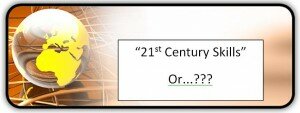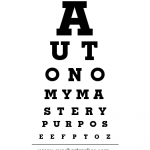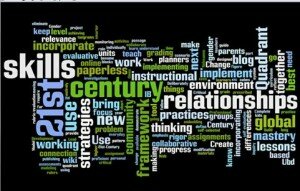Archives
| M | T | W | T | F | S | S |
|---|---|---|---|---|---|---|
| « Jan | Mar » | |||||
| 1 | 2 | 3 | 4 | 5 | 6 | |
| 7 | 8 | 9 | 10 | 11 | 12 | 13 |
| 14 | 15 | 16 | 17 | 18 | 19 | 20 |
| 21 | 22 | 23 | 24 | 25 | 26 | 27 |
| 28 | ||||||
“21st Century Skills,” Powerful Learning & Educational Reform

I am a “21st century learning and innovation specialist. “ I am asked over and over again about my job title – and I understand that a lot of people are tired of the worn out phrase “21st century learning” or “21st century skills.” I, too, think that a decade into this thing, we would really be better off defining 21st century learning and perhaps replacing this term with what we really mean. So what would you call it? That’s where I get stuck. It is just so hard to put a label on it. To me “21st century learning” is huge – and represents something much, much bigger than what might enter most people’s consciousness when they hear the term. To me, it embodies the educational reform that we all seek.
Here is how I like to explain it when I have a little time at a workshop or presentation for parents or community members – even teachers, I ask them to think about one of their most powerful learning experiences. Typically, in a workshop, I’ll give individuals time to reflect, and then ask them to form small groups and share their powerful learning experiences with each other. Following this, their task is to create a list of the common elements of their experiences. Then we share the results with the whole group. Guess what? The list is always the same. What’s on it?
- Hands-on, active learning
- Real-world problem solving/connections to community
- Collaborative
- Challenging
- Built-in time for reflection
- Feel safe to “fail”
- Ability to build a relationship with the teacher
The next thing I like to do is point out that there is a fortunate connection between what produces powerful learning – enduring understandings, if you will, and 21st century learning . All of the things listed above detail environmental aspects of learning. They aren’t what the teacher teaches, per say, but how he/she designs the learning activities to allow room for these things to occur.
21st Century Learning is much the same. Here are some typical 21st century skills identified by any number of educational think tanks:
- Collaboration
- Critical Thinking/Reasoning
- Innovation
- Self Direction
Do you see where I’m going with this?

I think that it is pretty amazing that the things that we consider powerful about our own learning, that we might even call motivational factors of learning, are so similar to the skills that we need to address according to the various 21st century learning think tank and workforce studies. Could this mean…we know what to do? We know how to motivate kids? We know how to ensure that they acquire both skills and understandings? So what is standing in our way? Oh. Yeah. Educational reform. Standardized testing. Lack of time. (see standardized testing).
I just learned about a new film being developed by Laurie Gabriel called Hear our Teachers. I am very excited about this new film and the hope of finding some balance between what teachers know about how students learn and the sentiments being expressed by the Waiting for Superman and Education Nation crowds.
I think as we move forward, we need to keep the focus on students and how they learn. Let’s set the political agendas aside and stop pointing fingers for awhile and find some common ground in our discussions about educational reform. I think that powerful learning – “21st century learning” – is our common ground. Can this be our starting point for productive conversations about how to improve student learning?
Moving from Student to Learner: An Educon Reflection
 I went to Educon this year on a quest, prompted by very candid remarks and stories shared by a student panel which was featured at the final meeting of our district’s 21st Century Learning Cadre. I wanted to find examples of teachers and schools successfully addressing the key areas these students consistently shared as highly important elements of the school experience for them. No surprise, the elements that stood out in their responses were relationships and real world connections.
I went to Educon this year on a quest, prompted by very candid remarks and stories shared by a student panel which was featured at the final meeting of our district’s 21st Century Learning Cadre. I wanted to find examples of teachers and schools successfully addressing the key areas these students consistently shared as highly important elements of the school experience for them. No surprise, the elements that stood out in their responses were relationships and real world connections.
Again, no surprise, I found the answers at SLA itself, in talking with students and attending sessions like Interdisciplinarity, facilitated by SLA teachers Zac Chase, Rosalind Echols and Diana Laufenberg, as well as the impromptu session on Friday hosted by several students who shared information on their Capstone projects, which are hands-on, real-world projects all SLA students do in their senior year. And from our student tour guide who spoke with such poise and exhibited such pride in her school and accomplishments there.
The real magic at SLA is that this is a place where shift has happened. Teachers don’t own the learning. Students do. They look forward to it. They embrace the challenge. It is hard to believe these are high school students. They exhibit incredible maturity, intelligence and understanding. It is obvious there is some sort of driving force at work – and it really doesn’t seem to be grades. These students have a passion for learning. How did they get here? What is it that ignites such passion for learning in these students? How can I bring some of these ideas and practices back to my district and achieve this kind of transformation – the real reform that we are all seeking?
First of all, it is important to note that the SLA students were highly motivated to begin with. They had to apply and go through a very competitive selection process to be able to attend SLA. That makes this quite different from a traditional public school that contains a real mix of both willing and unwilling students. But I don’t think we can dismiss the possibility of adopting some of the core beliefs and practices of SLA to begin a transformation in our own schools. If it is working for this group of students, I can’t help but think that employing some of these same beliefs and practices in schools where students are less-than-motivated will have an even more profound effect. Here’s why.
The very same beliefs and practices that were wished for by the student panel last week in my school district are actually put into practice at SLA. Not some of the time. All of the time. Here is what I observed and learned about at SLA that I believe are the answers – the pathway to achieve schools that transform students into self-motivated learners.
 Relationships – this seems like such a simple thing, but really, it is not. And certainly not something we should trivialize. As Chris Lehmann said in his blog awhile back, you have to plan for it.
Relationships – this seems like such a simple thing, but really, it is not. And certainly not something we should trivialize. As Chris Lehmann said in his blog awhile back, you have to plan for it.
At SLA, we say that the way we treat each other is based on the ethic of care — the idea that caring relationships are at the heart of creating healthy learning environments. That idea has to live somewhere or eventually it will get squeezed out or only live within the people who came in already believing it. This is why we have Advisory — a four year relationship between a group of twenty students and a teacher that ensures that every teacher has a group of kids for whom they are responsible and every students has an adult in the building who will always be their advocate. We had to plan for caring, we couldn’t just assume it, and we certainly couldn’t just say it. (Lehmann, Nov. 13 2008. Practical Theory: “Where Does it Live?” http://practicaltheory.org/serendipity/index.php?serendipity[action]=search&serendipity[searchTerm]=relationships_)
In almost every conversation I had with students at Educon, evidence of this level of caring and relationships was shared. One student’s story in particular stands out to me. She said that when she first came to SLA in the 9th grade, she was extremely stressed out, worried about her grades, and subsequently, not getting very good grades. She met frequently with Chris, who encouraged her to stop worrying so much, find what she enjoys and is passionate about and go from there. He encouraged her to follow her own dreams. She said when she finally listened to him and did just that, she was amazed! She began to really enjoy all of her classes, and all of her grades improved.
Related to relationships, the culture at SLA also is about a high level of trust. One student, when sharing information on her senior Capstone project, commented that sometimes students get very involved in these projects, allowing other class work to “pile up.” When asked to elaborate on this, she shrugged it off. She said we know what we need to do, and we’ll get it done. It’s not a big deal. My take on this – no one is going to nag them. They accept full responsibility for their work and will take care of it. What a concept.

Real-World Connections and Active Learning were also on the “wish list” from my student panel regarding how they would like to change their school experience. Based on my observations, it seems that everything that happens at SLA is purposefully connected to the “real world” and learning is always hands on and project based. To start with, every student has an Individualized Learning Plan, and Juniors & Seniors are paired with a mentor from business or the community. They work on real projects side by side with professionals, or they pursue more in depth classes at the university level. Student capstone projects are the culminating project from this experience. Some that we learned about ranged from a student writing a screenplay to a student conducting research on student attitudes toward sexual abstinence, to robotics experimentation. Early dismissal on Wednesday has a purpose for students. It is when they can apply what they learn in the classroom to the real world through internships and real world projects. And in the classroom, active learning abounds. The curriculum is powered by inquiry. Textbooks are just one resource. The world is their textbook. I learned about an amazing interdisciplinary project that Diana Laufenberg and Zac Chase do with their history and English classes. The students selected a particular building in Philadelphia that contains a person’s name and they conduct research to determine the history of the building, and the connection to community. This is just one example of the backwards-designed UbD units which all teachers create. Questions guide the learning, and students do the investigating to seek out answers and explanations.
 How can we get there? Ideally, our schools and districts should adopt the same philosophy and mission that SLA has: that “students should learn in a project-based environment where the core values of inquiry, research, collaboration, presentation and reflection are emphasized in all classes.” Of course, individual teachers can advocate for this in their schools, but the reality is, they may not have the kind of influence to bring about this change school and district wide. But they can do this in their own classrooms, and model it. Here is a list of things I believe every teacher can and should do. This is a good starting point to start bringing some of the magic of SLA into your own classroom. These are the things I observed SLA teachers, and of course their principal, Chris Lehmann doing:
How can we get there? Ideally, our schools and districts should adopt the same philosophy and mission that SLA has: that “students should learn in a project-based environment where the core values of inquiry, research, collaboration, presentation and reflection are emphasized in all classes.” Of course, individual teachers can advocate for this in their schools, but the reality is, they may not have the kind of influence to bring about this change school and district wide. But they can do this in their own classrooms, and model it. Here is a list of things I believe every teacher can and should do. This is a good starting point to start bringing some of the magic of SLA into your own classroom. These are the things I observed SLA teachers, and of course their principal, Chris Lehmann doing:
- Model being a learner
- Create a culture of trust
- Create sense of team with the staff
- Expectations for relationships with students
- Laugh ! Play!
- Respect – students and each other
- Teach students – not subjects. Be passionate about them and how well they understand.
- Think out loud all the time
- Build pride based on academics
- Connect every learning experience to the real world
- Bring the real world into the classroom
- Let students ask questions. Model how to find answers.
- Allow room for choice, but be ready with support if it is needed
- Put students in charge of their own learning. Just say it. And mean it.
- Talk to students about concerns over their understanding. Not their grade.
My heartfelt thanks to Chris and the staff, students, and parents at SLA for this incredible, inspirational glimpse at what education can and should be.



